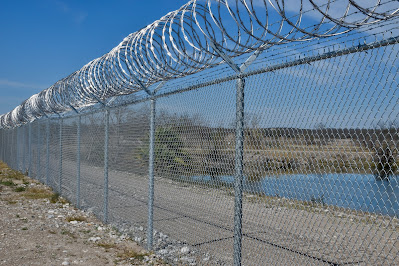Del Rio
Our travels have halted for a few days at Del Rio. It seemed a convenient stopping-over spot after our two ten-hour driving days. An added inducement was Amistad Lake, a huge reservoir with shorelines in both Mexco and the United States. We fished there successfully years back, but were skunked at our first angling attempt this trip.
Because the water level is so low, it was quite a chore to inch our way down over jumbles of loose limestone rocks.
We did plump up the bird list whilst we whiled away the time, though, with common loon, greater yellowlegs, eared grebe, ring-billed gull and rock wren.
As we began explores on non-lake terra firma, we learned some about the town and surrounding region. Like darn near every other city in the country, Del Rio has a long commercial strip that could be the same commercial strip as any other place, lined with familiar chain big box stores and fast food joints. Very disappointing to see that state of affairs. As is our wont, we set off to find "old town", which in this case, included the Barrio of San Felipe.
Originally, the settlement was called San Felipe Del Rio, but authorities would not allow the post office that moniker because it would be confused with another San Felipe. In their infinite wisdom, they shortened the name to its present version.
There remains a large residential section of historic dwellings, most not very prosperous in appearance, and the original downtown has succumbed to the outward movement of commercial enterprises.
Anglo settlers were in the area as early as the 17th century, no doubt because of abundant spring and river water. In 1675, Spanish priests named the multiple springs for the king of Spain - San Felipe. Comanches camped at the flowing water sources, and in 1808, a mission was established on San Felipe Creek.
I had read about San Felipe Springs, so we set off to find where they are on the golf course of the country club. My pathfinder pard got us to the place, but public access was closed off for reasons unexplained. A locked gate backed up the sign barring our forward movement. Not to be deterred, we found our way to where the creek crossed the highway and then to the country club golf course where I asked a maintenance man if we could go in that way. He waved us on with an admonition to be careful we didn't get hit by a golf ball. Perhaps our agreement sufficed as a liability waiver . . .
It was a totally awesome walk along the crystal clear creek. After wandering a goodly distance here and there, we ended up on the inside of the locked gate we weren't supposed to go past. All was serene and beautiful and we had a super time birding.
We enjoyed seeing non-avian denizens of the area, too.
Chinaberry trees abound through there. They provided painful missiles for neighborhood child wars when I was young.
Much more fun than golfing, in my opinion. Birds we identified there were great kiskadee, vermillion flycatcher, black phoebe, northern cardinal, eastern phoebe, ringed kingfisher, northern mockingbird, yellow-rumped warbler, great blue heron and a life bird: golden-fronted woodpecker. We also saw that one at the RV park.
There are ten or more springs flowing out of the ground along San Felipe Creek, providing a stupendous amount of water for irrigation, urban use and wonderful swimming holes. They also supply nearby Laughlin Air Force Base.
Illegal immigrants . . .
The mention of a military facility brings me to a more current situation. The recent attempted invasion of 16,000+/- migrants from Haiti occurred at the port of entry near Del Rio. As a consequence, a huge National Guard installation has been established, consisting of acres of identical mobile units for housing the troops.
Soldiers detained many supposed asylum seekers who were returned to Mexico and Haiti. The Guardsmen are working in conjunction with other teams to construct border fencing. In our wanders, we saw three different border fences/walls. The third photo is what we believe the National Guard is working on.
More water, more birds . . .
It was fascinating and fun to wander back roads just to see what was there. As it turned out, much of what was there was water. We finally got to the Rio Grande, but did not find access along it, at least in that region. It was all private property with many abandoned houses. I took this shot of a nice outdoor seating area on the river's bank; however, the owners live in a converted storage unit. I saw one window cut into it with curtains drawn back.
One narrow dirt track lured us on for a bit, but as it wound down through a low-running creek and thick brushy area, I deemed it a little too chancy to continue. Country club golfers we talked to said there are troubles with illegals still coming across, 100 or more per day, many criminal and mentally unstable.
We did stop at many large ponds and waterways, though, and identified more birds to add to the trip list: greylag goose, great egret, double-crested cormorant, mallard, pintail, redhead, bufflehead, ring-necked duck, pied-billed grebe and osprey, plus a red-shouldered hawk that flew right in front of us.













2 comments:
If you go to brackettville stop at the Seminole cemetery where 4 MOH are from 1870s
I finally got caught up on the Blog. You two find the craziest and most interesting sites to visit and share. Thanks for taking me along. I'm really tired of being home for over two years. azlaydey
Post a Comment